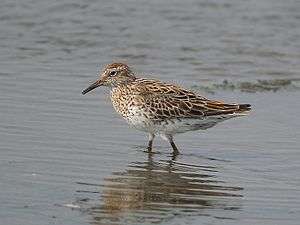Watervalley Wetlands

The Watervalley Wetlands consist of a series of contiguous wetlands, lying on 131 km2 of private land between the Coorong National Park and Gum Lagoon Conservation Park, in the Limestone Coast region of south-eastern South Australia.
Description
The wetlands comprise Mandina Marshes, Mandina Lake, Cortina Lakes, Mrs Whites Lagoon, Caora and South Flagstaff, which form a chain between relict dune systems inland of the Coorong, about 250 km south-east of Adelaide. The water in the wetlands ranges from fresh to saline according to seasonal conditions. The area has a Mediterranean climate with cool, wet winters and warm, dry summers, and with an average annual rainfall of 450-500 mm. Most of the land is owned by Wetlands & Wildlife, a private conservation and land rehabilitation company, with the remainder expected to become the property of the company in due course.[1]
Fauna
Birds
The site has been identified as an Important Bird Area (IBA) by BirdLife International because it supports over 1% of the world populations of sharp-tailed sandpipers, and sometimes of blue-billed and musk ducks, when water levels are suitable. It also provides habitat for diamond firetails.[2] Other birds of conservation significance present at the wetlands include black-backed and Australasian bitterns, freckled ducks, Australasian shovellers, white-bellied sea-eagles, peregrine falcons, Latham's snipes, Baillon’s and spotless crakes, yellow-tailed black cockatoos, southern emu-wrens, chestnut-rumped heathwrens, diamond and beautiful firetails, and black-chinned honeyeaters. The wetlands also support large breeding colonies of several thousand ibises, egrets, spoonbills and cormorants.[1]
Other animals
The site is home to red-necked wallabies and common wombats at the extreme western limit of their range. Rosenberg's goannas are present. Growling grass frogs and Yarra pygmy perch have been recorded.[1]
External links
References
- 1 2 3 BirdLife International. (2011). Important Bird Areas factsheet: Watervalley Wetlands. Downloaded from http://www.birdlife.org on 2011-11-21.
- ↑ "Important Bird Areas factsheet: Gum Lagoon". BirdLife International. 2015. Retrieved 17 September 2015.
Coordinates: 36°17′26″S 139°55′45″E / 36.29056°S 139.92917°E